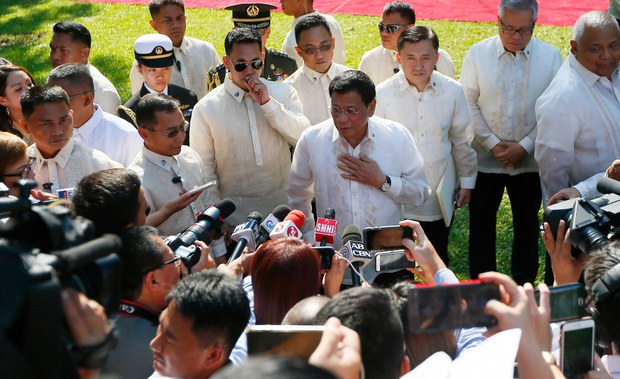Philippine Leader Backtracks, Says No Substantial Evidence in Alleged Ouster Plot
2019.05.01
Manila and Davao, Philippines
 Philippine President Rodrigo Duterte talks to reporters outside the Malacañang Palace in Manila, April 28, 2017.
Philippine President Rodrigo Duterte talks to reporters outside the Malacañang Palace in Manila, April 28, 2017.
The Philippine government admitted Wednesday that it had no substantial evidence about an alleged plot to oust President Rodrigo Duterte, and would only file lawsuits against the alleged conspirators once an actual crime was committed.
This was contrary to an earlier pronouncement from Duterte’s spokesman, Salvador Panelo, who told reporters last week that the public should believe the allegation because it came directly from the chief executive himself.
The reported ouster against Duterte was announced by the government through a “matrix” – a graphic that names those who were allegedly involved in the plot. The Manila Times, a national daily newspaper, published the graphic and a report naming several Filipino journalists and rights activists, but offered no proof and did not name its sources.
“Those named in the matrix demand proof of their participation in the ouster plot,” Panelo told reporters Wednesday. “Such is totally unnecessary. The matrix shows that there is an ouster plot. It is just a plot, a plan, an idea. The same is not actionable in court it being just a conspiracy.”
Panelo said that the information originated from another country, which he declined to name. Duterte did not know how such information was gathered, he said.
“The possibilities are endless,” Panelo said, adding that the president’s office released the matrix to put the plot leaders “on notice that pursuing their plan by committing overt acts punishable by law will open themselves to criminal persecution.”
“The critics cry that the move to reveal the ouster plot was meant to stifle political dissent and opposition,” he said, but noted that the government has allowed to express their dissent through a democratic space.
The New York-based Committee to Protect Journalists (CPJ) slammed the government after the Times published the story and the graphic that also alleged that three news organizations – Rappler, Vera Files and the Philippine Center for Investigative Journalism (PCIJ) – were involved in a plot to oust the president.
The plot also allegedly included the National Union of People’s Lawyers, a group of left-leaning attorneys who represent cause-oriented groups and individuals.
Panelo had said earlier that he did not know how the Times obtained the matrix, but confirmed that the plot came from the president’s office. Duterte himself has not personally addressed the alleged matrix.
Rappler, Vera Files and the Philippine Center for Investigative Journalism have extensively covered Duterte’s crackdown against drugs that left thousands of people dead since 2016.
Before the matrix came out, Duterte threatened to “return the favor” against PCIJ after it published a report detailing the large increase in the president’s wealth.







